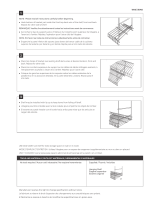
English 2
Important Installation Information
GAS Type Verification
Verify that the appliance is correct for the type of gas
provided at installation location. Ensure that the appliance is
connected to the type of gas for which it is certified. Before
proceeding with the installation refer to “Step 6: Gas
Requirements and Hookup” on page 14
All models are certified for use with natural gas. Field
conversion of the appliance for use with propane gas supply
will require installation of conversion kit supplied with the
range (service number 553182). Only a qualified service
technician or installer should make this conversion. See LP
Conversion Kit instructions for full installation information.
WARNING:
To avoid possible burn or fire hazard, a
backguard designed specifically for this range
must be installed whenever the range is used.
Refer to “Backguard Kit Model Numbers” on page 24, for
the correct backguard models that are designed for this
range. After selecting the correct backguard, the range
must be installed properly, using the minimum clearances
to combustible surfaces specified in “Step 2: Cabinet
Preparation” on page 4.
Important:
For island installations and other installations with more
than 12” (305mm) minimum horizontal clearance between
combustible materials and the back edge of the range, a
Flush Island Trim has been supplied with the range (refer
to “Figure 2: Side View Of Clearances” on page 6). A
THERMADOR
®
Low Back or High Shelf must be
purchased separately and utilized when there is less than a
12” (305mm) horizontal clearance.
Gas Supply:
Natural Gas – 6” water column (14.9 mb) min., 14” (34.9
mb) maximum
Propane Gas – 11” water column (27.4 mb) min., 14” (34.9
mb) maximum
Electric Power Supply:
See “Step 7: Electrical Requirements, Connection &
Grounding” on page 16 for specifications.
This appliance has been tested in accordance with ANSI
Z21.1, Standard for Household Cooking Appliances (USA)
and in accordance with CAN 1.1-M81 Domestic Gas
Ranges (Canadian).
Check local building codes for the proper method of
appliance installation. Installation, electrical connections
and grounding must comply with all applicable codes. Local
codes vary and it is the responsibility of the installer to
ensure installation is in accordance with these codes. In the
absence of local codes the appliance should be installed in
accordance with the National Fuel Gas Code ANSI Z223.1/
NFPA 54 current issue and National Electrical Code ANSI/
NFPA 70-current issue. In Canada, installation must be in
accordance with the CAN 1-B149.1 and.2 – Installation
Codes for Gas Burning Appliances and/or local codes.
This appliance complies with one or more of the following
standards:
• UL 858, Standard for the Safety of Household Electric
Ranges
• UL 923, Standard for the Safety of Microwave Cooking
Appliances
• UL 507, Standard for the Safety of Electric Fans
• ANSI Z21.1, American National Standard for Household
Cooking Gas Appliances
• CAN/CSA-C22.2 No. 113-10 Fans and Ventilators
• CAN/CSA-C22.2 No. 61-08 Household Cooking Ranges
It is the responsibility of the owner and the installer to
determine if additional requirements and/or standards
apply to specific installations.
It is strongly recommended that this appliance be installed
in conjunction with a suitable overhead vent hood (see
“Step 1: Ventilation Requirements” on page 3). Due to the
high heat capability of this unit, particular attention should
be paid to the hood and duct work installation to assure it
meets local building codes.
CAUTIONS:
• To eliminate risk of burns or fire caused by
reaching over heated units, cabinet storage
above the surface units should be avoided.
• When connecting the unit to propane gas,
make certain the propane gas tank is
equipped with its own high-pressure regulator
in addition to the pressure regulator supplied
with the range. The maximum gas pressure to
this appliance must not exceed 14.0 inches
water column (34.9 mb) from the propane gas
tank to the pressure regulator.
• This unit is designed as a cooking appliance.
Based on safety considerations, never use it
for warming or heating a room.





















